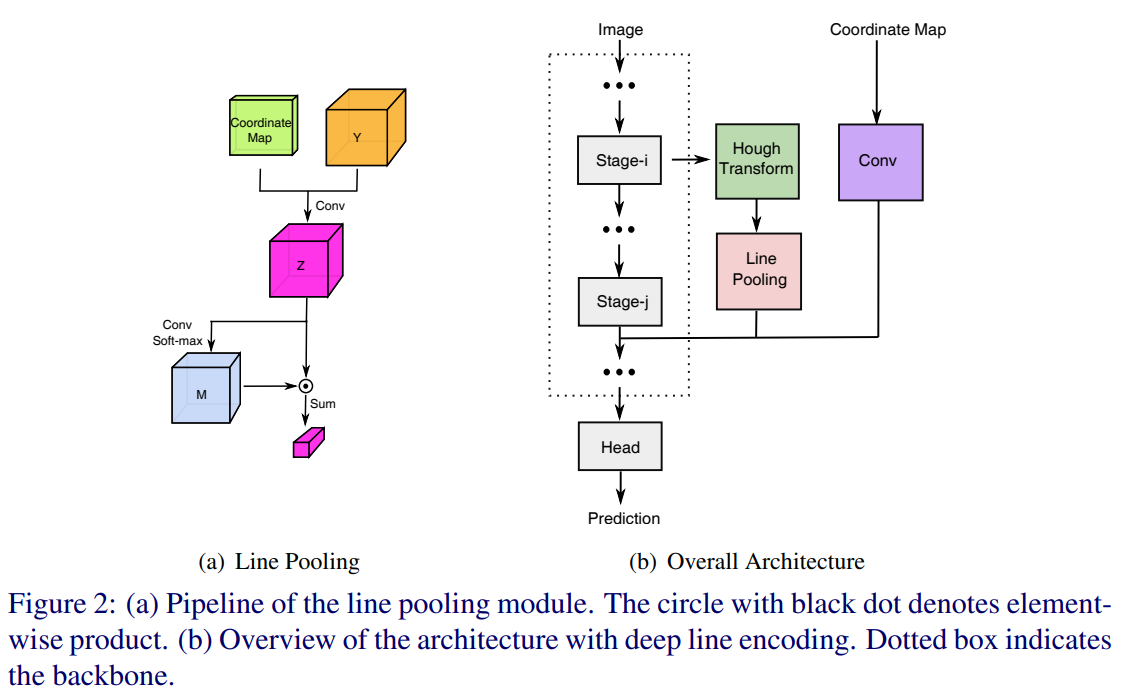Deep Line Encoding for Monocular 3D Object Detection and Depth Prediction
这篇paper在GAC 文章与代码的基础进一步开发.
由于驾驶场景地面不一定是平整的,但是地面上的线特征可以辅助网络学习这些信息.本文就着重从线特征提取来入手进一步提升GAC的性能.

其主要修改了Core Module的流程代码.
class SelfMask(nn.Module):
"""
The Conv Soft-max operation on (a) subgraph to select the most significant line at each channel.
"""
def __init__(self, c):
super(SelfMask, self).__init__()
self.mask1 = nn.Conv2d(c, c, kernel_size=1)
self.max1 = nn.Softmax(dim=-1)
def forward(self, x):
mask1 = self.mask1(x)
n, c, h, w = mask1.shape[0], mask1.shape[1], mask1.shape[2], mask1.shape[3]
mask1 = mask1.view(n, c, -1)
mask1 = self.max1(mask1)
mask1 = mask1.view(n, c, h, w)
x1 = x * mask1
x1 = x1.sum(dim=-1,keepdim=True).sum(dim=-2,keepdim=True)
return x1
class YoloMono3DCore(nn.Module):
"""Some Information about YoloMono3DCore"""
def __init__(self, backbone_arguments=dict()):
super(YoloMono3DCore, self).__init__()
self.backbone =resnet(**backbone_arguments)
self.cord = nn.Sequential(
CoordinateConv(256+512, 512, kernel_size=3, padding=1),
nn.BatchNorm2d(512),
nn.ReLU(True),
nn.Conv2d(512, 512, kernel_size=3, padding=1),
nn.BatchNorm2d(512),
nn.ReLU(True)) # The coorindate Conv after line pooling on (b) subgraph
self.vote_index = hough_transform(72,320,3.0,3.0)
self.vote_index = torch.tensor(self.vote_index).cuda().contiguous().float()
self.dht = HT(self.vote_index) # Hough Transform Layer
self.dht_backbone = nn.Sequential(
CoordinateConv(16, 64, kernel_size=3, padding=1),
nn.BatchNorm2d(64),
nn.ReLU(True),
nn.Conv2d(64, 256, kernel_size=3, padding=1),
nn.BatchNorm2d(256),
nn.ReLU(True),
SelfMask(256)) # Line Pooling Module
self.bt = nn.Sequential(
nn.Conv2d(256, 64, kernel_size=1),
nn.BatchNorm2d(64),
nn.ReLU(True),
nn.Conv2d(64, 16, kernel_size=1),
nn.BatchNorm2d(16),
nn.ReLU(True)) # Compress the number of channels for hough transform.
def forward(self, x):
#x = self.backbone(x['image'])
#x = x[0]
x1, x2 = self.backbone.forward1(x['image']) # Take the ResNet's output from layer1 and layer2; scale 4, 8
x1 = 0.1 * x1 + 0.9 * x1.detach()
x1 = self.bt(x1) # Reduce features before hough transform
dht = self.dht(x1) # hough transform
dht = self.dht_backbone(dht) # Line Pooling
h, w = x2.shape[2], x2.shape[3]
dht = dht.expand(-1, -1, h, w)
x2 = torch.cat([x2, dht], 1)
x2 = self.cord(x2) # Merge back
x2 = self.backbone.forward2(x2) # ResNet at Scale 16
return x2